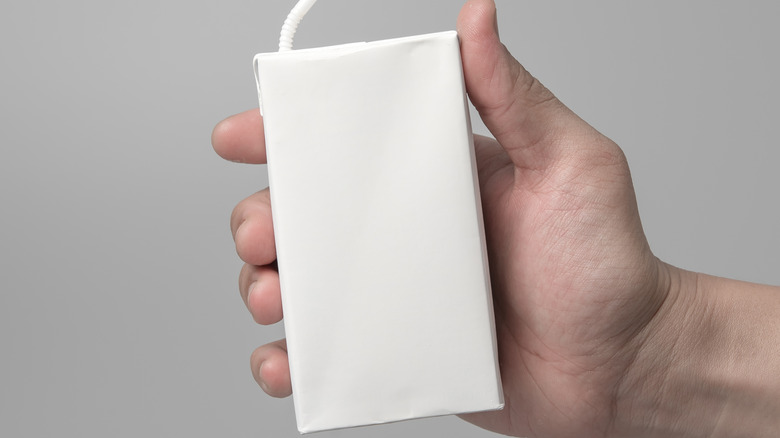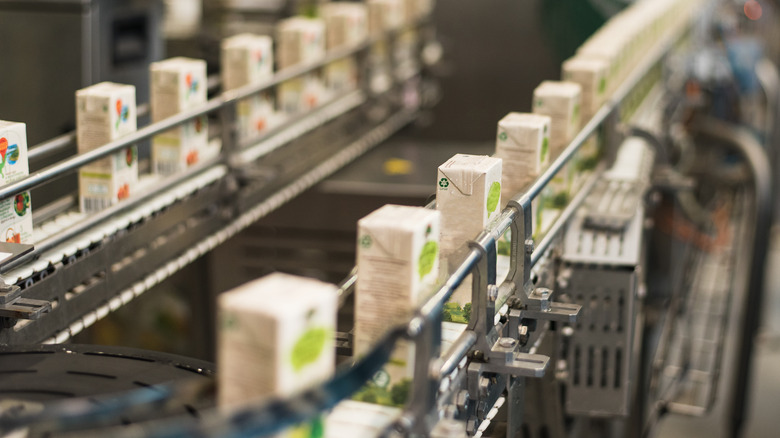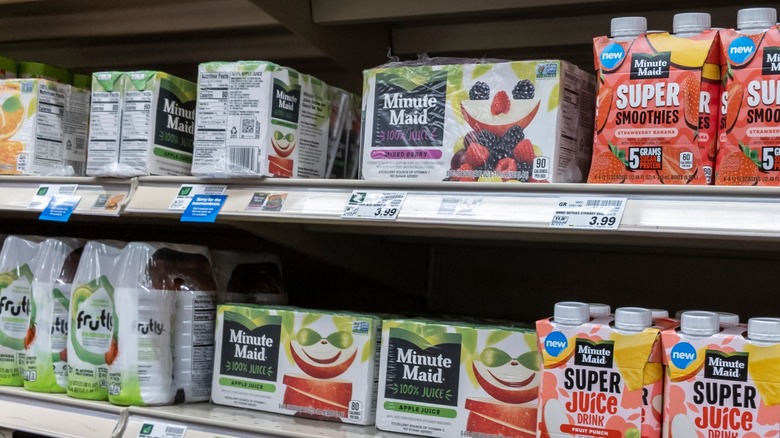Here's Why You Don't Have To Refrigerate Juice Boxes
Imagine you're at the grocery store. You walk down the refrigerator aisle, where you see containers of orange juice, lemonade, and other fruit juices. On the room-temperature shelves, you see plastic apple juice containers and paperboard juice boxes. You've probably walked past both aisles a hundred times, but have you ever wondered why those adorable little juice boxes don't need to be refrigerated?
If you have kids who keep losing their lunch ice packs, you're probably too busy just being grateful for the shelf-stable nature of juice boxes to wonder why they're shelf-stable. The fact that these boxed beverages can be stored all day long in a lunch bag without an ice pack or in your pantry (via StillTasty) is so convenient, why think twice about it?
There is, however, a pretty logical, straightforward explanation for why certain juices need to be refrigerated and others don't, and it all boils down to packaging and the inevitability of science. To be more specific, juice boxes don't need to be refrigerated because they are packaged differently than other juices, like those in clear plastic bottles.
How are juice boxes packaged?
Fruit juice comes packaged in a variety of container types, including plastic, glass, paperboard, and aluminum, but not all packaging materials are created equal. Paperboard juice box packaging falls in the category of aseptic containers. Encyclopedia.com defines an aseptic container as one that "is manufactured and filled under sterile conditions and requires no refrigeration or preservatives to remain germ-free."
The juice box aseptic packaging process involves several layers of raw materials, including a consumer plastic called polyethylene that serves as a barrier on the inside and outside of the box. It forms a seal that prevents liquid from getting into the box and from leaking out, unless, of course, the box is punctured. On the outside of the box, polyethylene keeps the package dry with a protective coating (via Eagle Flexible Packaging).
Another preventive layer of the box is aluminum foil, which protects against light and oxygen exposure. This specific layer is what eliminates the need for refrigeration or preservatives, making the package a shelf-stable item (per Scholle IPN).
According to the U.S. Food & Drug Administration, aseptic packaging was first developed in Europe to provide beverages to people who were involved in some type of natural disaster. The United States began using aseptic packaging in 1980. In addition to extending the shelf life of foods and beverages and eliminating the need for preservatives, aseptic packaging reduces shipping costs and increases transportation efficiencies (per Food Drive).
How long is a juice box safe to drink after opening?
Unopened, properly stored juice boxes can sit comfortably in your pantry or refrigerator for up to three months, according to EatByDate. But once you pierce that tiny aluminum foil straw opening, the "life clock" starts ticking. EatByDate's Fruit Juice Expiration Date chart claims an opened juice box can last up to three days in the refrigerator, while StillTasty claims it can last up to a week.
It's also important to note that since there are no preservatives used in the juice, even a tiny puncture to the box starts the clock, even if it doesn't cause the juice to leak. That's because air can still get inside the box and cause mold to grow over time if not refrigerated. KSDK reported one of several incidents involving thick, green mold that formed on the inside of a juice box as a result of a tiny puncture.
Aseptic packaging offers a range of benefits to consumers, but unfortunately, the benefits do come with these mold risks. Of course, nobody wants to find anything growing in their beverage, so be sure to thoroughly examine your juice boxes and other aseptically packaged items for punctures or signs of mold. If you find one, throw it away.


